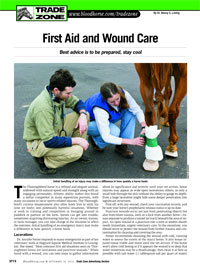Trade Zone: First Aid and Wound Care - Click Here to Download PDF

The Thoroughbred horse is a refined and elegant animal, endowed with natural speed and strength along with an
engaging personality. Athletic ability makes this breed a stellar competitor in many equestrian pursuits, with
many occasions to incur sports-related injuries. The Thoroughbred’s curious temperament also often leads him to stick his
nose (or body) into potentially harmful situations. Whether at work in training and competition or lounging around in
paddock or pasture on the farm, horses can get into trouble, sometimes acquiring distressing injuries. As an owner, trainer,
or farm manager, you can take charge of the situation to affect the outcome. Initial handling of an emergency injury may make
a difference in how quickly a horse heals.
LACERATIONS
Dr. Jennifer Feiner responds to many emergencies as part of her
veterinary work at Hagyard Equine Medical Institute in Lexington.
She noted, “Most common first aid situations seen on Thoroughbred
farms are lacerations and puncture wounds.” When
faced with a wound, you can take steps to gather information
about its significance and severity until your vet arrives. Some
injuries may appear as wide-open lacerations; others, as only a
small hole through the skin without the ability to gauge its depth.
Even a large laceration might hide some deeper penetration into
significant structures.
First off, with any wound, check your vaccination records, and
be sure your horse’s prophylactic tetanus status is up-to-date.
Puncture wounds occur not just from penetrating objects but
also from blunt trauma, such as a kick from another horse—tissues
separate to produce a tunnel (or tract) beneath the area of impact.
An open wound or a puncture into a joint or tendon sheath
needs immediate, urgent veterinary care. In the meantime, you
should strive to protect the wound from further trauma and contamination
by cleaning and covering the area.
Feiner recommends cleansing the wound with cold, running
water to assess the extent of the injury better. It also keeps injured
tissue viable and moist until the vet arrives. If the horse
won’t allow cold hosing or if it appears the wound is so deep that
water immersion may be a disadvantage, then clean it as best as
possible with salt water (1⁄2 tablespoon salt per quart of water)
and antiseptic scrub (povidone iodine or
chlorhexidine). Rinse well, dry, and then
apply a bandage.
To continue reading, click the "Download" button at the bottom of this page.
Sponsors:
Morinda Care (www.morindacare.com)
Life Data Labs, Inc. (www.lifedatalabs.com)
Neogen (www.neogen.com)
Turnbow Trailers, Inc. (www.turnbowtrailers.com)
Loomix Cellarator (www.cellarator.com)
Dandy Products, Inc. (www.dandyproducts.net)
Farrier Product Distribution (www.farrierproducts.com)
OCD Pellets (www.ocdpellets.com)
Horsemen's Track and Equipment, Inc. (www.horsemenstrack.com)
Looking at EPM
- August, 21, 2010
A Safer Ride
- July 17, 2010
Hoof Care for Thoroughbreds
- June 12, 2010
Parasite Control - May 22, 2010
AAEP Focus on Disease Treatment, Prevention - April 24, 2010
AAEP 2009: Focus on Horse Health News - March 20, 2010
AAEP 2009: The Latest on Lameness Treatments - February 13, 2010
Foal Health - January 9, 2009
Common Reproductive Problems in Mares - December 5, 2009
The Third Trimester - November 14, 2009
Ready to Run - October 31, 2009
Feeding For the Ages - September 19, 2009
Transportation Tips - September 5, 2009
Disease Control Yearly Planner - August 8, 2009
Foot Flops & Fixes - July 25, 2009
Get Ready - June 26, 2009
Therapy For Thoroughbreds - May 5, 2009
Dirt or Synthetic - Which is Safer? - April 25, 2009
AAEP: Focus on Horse Health News - March 21, 2009
Infectious Disease at the AAEP Convention - February 21, 2009
When Foaling Goes Wrong - December 6, 2008
Feeding the Pregnant Mare - November 15, 2008
Broodmare Vaccinations - November 1, 2008
Transport Stress in Horses - October 18, 2008
View more...




